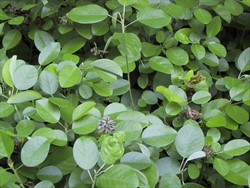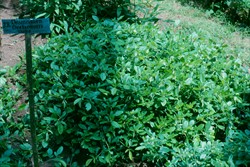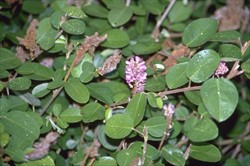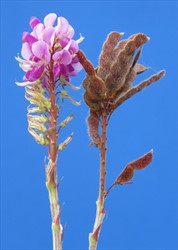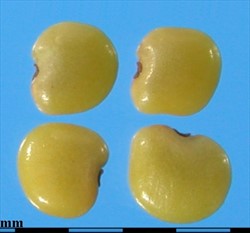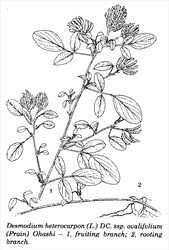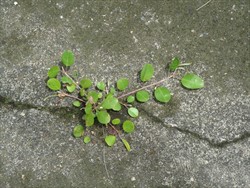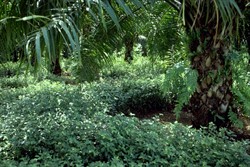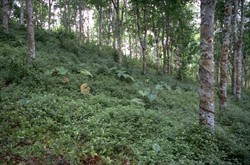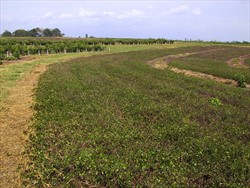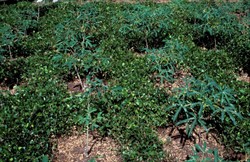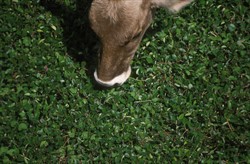Tropical Forages
Grona heterocarpa (L.) H. Ohashi & K. Ohashi subsp. ovalifolia (Prain) H. Ohashi & K. Ohashi
Basionym: Desmodium polycarpon (Poir.) DC. var. ovalifolium Prain; Grona heterocarpa (L.) DC. subsp. ovalifolium (Prain) H. Ohashi; Desmodium ovalifolium (Prain) Wall. ex Merr.
Family: Fabaceae (alt. Leguminosae) subfamily: Faboideae tribe: Desmodieae.
An aggressively creeping, stoloniferous legume that may reach 1 m height in dense stands. Stems are multi-branched and quite woody at their base. Young plants always have single broadly elliptical leaves; on more mature plants leaves may be unifoliolate or trifoliolate, with terminal leaflet larger than laterals. Terminal leaflets 30‒45 mm by 15‒30 mm. Leaflets coriaceous, without any markings, glabrous and glossy on upper surface, whitish-pubescent underneath. Inflorescence a densely flowered raceme 2‒5 cm long, with purple to dark pink flowers, turning bluish with age. Pods comprise 2‒8 almost quadratic segments, 2.5‒3.5 mm long, covered in dense hairs and held in a dense, erect cluster; dehiscent when ripe. Seeds ±kidney-shaped; yellow when ripe. About 500,000 seeds per kg.
subsp. ovaIifoIia: Prostrate stoloniferous herbs or subshrubs. Terminal leaflets ovate or elliptic to broadly ovate acute or obtuse glabrous or nearly glabrous above. Inflorescence short usually less than 5 cm long very densely flowered. Flowers more than 4 mm long with pedicels 2‒3 mm long. Pods with densely long yellowish or whitish hooked-hairs (0.5‒1.5 mm long).
subsp. heterocarpa: Erect or ascending or prostrate herbs or subshrubs. Terminal leaflets usually obovate elliptic or oblong sparsely to subdensely hairy above. Inflorescence elongated. Flowers 3‒4 mm long with pedicels 4‒7 mm long. Pods sparcely to densely pubescent with hooked and straight hairs (0.1‒1.5 mm long).
Description based on Ohashi (1991).
Asia: baay dam nnaep (Cambodia); akar entimor, buntut meyong sisir, kacang kayu betina, kaci, rumput kerbau derapah (Indonesia/Malaysia); huyo-huyop, mangkit-parang, mani-mani (Philippines); khonthi din (Thailand); tràng quả xoan (Vietnam)
English: desmodium, ovalifolium
Latin America: desmodio, desmodio oval (Spanish)
Native:
Asia: Cambodia, Indonesia, Laos, Malaysia (Peninsula), Myanmar, Philippines, Thailand, Vietnam
Cultivated:
Also cultivated.
Forage
Incorporated in grass/legume pastures in South America. Use in agro-forestry due to its shade tolerance and comparatively shallow rooting. Can be used for cut-and-carry, rehabilitation of degraded pastures and restoration of degraded soils.
Environment
Mainly used in southeast Asia as a cover crop for erosion and weed control in tropical tree plantations (including rubber, oil palm, coffee, tea), with potential use as a green manure. Soil improvement and soil erosion control via green manure and ground cover. Reduction of herbicide use when used for weed control.
Soil requirements
Very well adapted to low fertility, acid soils (pH 4‒7), with high Al and Mn, and low P. 64% of maximum yield is obtained at a soil Al saturation of 89% and soil P <2 ppm. When subjected to 86 ppm soil Mn, DM yield was higher than at 10 ppm, indicating excellent adaptation to acid soils. Adapted to both light textured as well as clay soils, including seasonally poorly drained conditions. Responsive to higher fertility soils.
Moisture
Humid and moist sub-humid tropical lowlands with 1,200‒4,500 mm annual rainfall, preferably >2,000 mm and a weak dry season of no more than 2‒3 months. Good tolerance of waterlogging and periodic flooding. Dry conditions can cause leaf drop and reduced flowering. Has performed well on seasonally flooded savannas in Colombia and on poorly drained humic gleys in the Brazilian savannas.
Temperature
Warm season growth only, being native to the lowland humid tropics and showing poor adaptation for growth beyond these environments. Best growth at low elevations (0‒300 m asl), but can grow at altitudes up to 1,800 m asl.
Light
One of the most shade tolerant leguminous cover/forage crops. Grows well under the heavy shade of rubber and oil palm plantations.
Reproductive development
Slow initial growth. Flowering and seed setting in the late wet and early dry seasons.
Defoliation
Good tolerance of grazing or cutting. Stocking rates in mixture with e.g. Urochloa humidicola should be kept high (3‒4 animals/ha) to maintain the grass component but adjustment during the dry season will be required.
Fire
Sensitive to burning, but fires are rare in its environmental adaptation range.
Guidelines for establishment and management of sown forages.
Establishment
Easy to establish from seed without full seedbed preparation; can be established from stolons. However, germination and establishment from seed are slow, so weed control is necessary at this stage. In pasture mixes, sown at 0.5 kg seed/ha. As a cover crop under plantation crops, sown at 1‒2 kg/ha, although rates of up to 5 kg/ha have been used. Seed should be scarified and preferably inoculated with strain of known effectiveness though there is ready nodulation with native cowpea type rhizobium. Seed can also be spread through the dung of grazing animals.
Fertilizer
On very acid infertile soils, the species responds to lime, phosphorus, potassium, magnesium, sulphur and boron fertilization.
Compatibility (with other species)
Weed control is necessary for establishment because of slow initial growth. Once established, it forms productive, persistent pastures with aggressive, stoloniferous, turf forming grasses such as Urochloa humidicola and U. decumbens. Can become dominant in pastures unless they are grazed heavily.
Companion species
Grasses: Urochloa decumbens, Andropogon gayanus and Megathrysus maximus. On fertile soils, the species is also reported to grow well with Cynodon nlemfuensis and Digitaria eriantha.
Legumes: Planted as a cover crop in southeast Asian plantation agriculture, often in a species mixture with one or more of the species Calopogonium caeruleum, , Centrosema molle and Neustanthus phaseoloides.
Pests and diseases
Susceptible to root-knot nematode (Meloidogyne javanica) and stem-gall nematode (Pterotylenchus cecidogenus), which in South America can destroy legume-only stands within 2 years. False rust or wart disease caused by the fungus Synchytrium desmodii is serious in Colombia and Ecuador, reducing soil seed reserves and seedling survival and yields by 70%. Foliar blight (Rhizoctonia solani) has been observed in humid regions of South America. Under experimental conditions, mycoplasma-like organisms have caused little leaf or witches broom.
Ability to spread
Will spread, and may become dominant in pastures, particularly on acid infertile soils and where grazing pressure is low.
Weed potential
Not considered to possess significant weed potential.
Nutritive value
Has only moderate nutritive value although fertilising with sulphur may improve this. CP 13‒21%; IVDMD values reported are low (range of 28‒51%), mineral concentrations are low to moderate (P 0.10‒0.24; Ca 0.27‒0.57). Digestibility and intake are reduced by high concentration of condensed tannins. CT concentrations ranged from 4 to 7% of DM based on ovalifolium standards, but analyses using less specific measurement techniques suggest much higher tannin concentrations (21‒43%). Animal performance and palatability data suggest that ovalifolium CTs may be highly astringent, binding relatively large amounts of protein per unit of tannin in comparison with CTs from other species (e.g. Leucaena leucocephala).
Palatability/acceptability
Cattle will reject the legume when first introduced to it. Palatability and intake are low but legume intake may increase as grasses mature later in the season. Sulphur fertilization has been found to improve palatability. Pen studies with sheep (wethers) show that variation in intake may be asymptotically related to level of DM on offer.
Toxicity
There are no reports of toxic compounds.
Dry matter
Dry matter yields of around 7 t/ha/yr have been recorded. In the Colombian savannas, yields of the legume in grass-legume swards ( Andropogon gayanus, Urochloa decumbens and U. humidicola) were 8‒9 t/ha, with legume contents of 42‒46%. Annual DM yields for mixtures of ovalifolium with U. decumbens or U. humidicola were 7.2 (50% legume) and 7.3 t/ha (38% legume), respectively. Dry season DM yields in multilocational trials in Colombia and Mexico were 0.02‒0.14 t/ha/2 months, wet season DM yields 0.4‒3.8 t/ha/2 months.
Animal production
Under grazing, produces 100‒700 g LWG/head/day. In the Colombian savannas, mixed pastures have produced LWGs of 264 kg/ha, 32% higher than from grass-only swards. In mixture with Cynodon nlemfuensis. As a companion legume, ovalifolium supported lower milk production than Stylosanthes guianensis, Centrosema macrocarpum and Arachis pintoi.
Hand harvested seed is marketed in Singapore. Seed production can be high with adequate moisture; yields of over 400 kg/ha have been obtained.
No information available.
- Very well adapted to acid, infertile soils.
- Combines with creeping, stoloniferous grasses such as Urochloa spp.
- High carrying capacity (persistent under heavy grazing).
- Good shade tolerance.
- Low palatability and nutritive value.
- Requires grazing management to maintain grass-legume balance.
- Poor drought tolerance.
Ohashi, H. and Ohashi, K. (2018) Grona, a Genus Separated from Desmodium (Leguminosae Tribe Desmodieae). Journal of Japanese Botany 93:104–120. jjbotany.com/pdf/JJB93-2_104-120_abstract.pdf
Pérez, R., Rincón, A., Cipagauta, M., Schmidt, A., Plazas, C. and Lascano, C. (2002). Maquenque [Desmodium heterocarpon (L.) DC subsp. ovalifolium (Prain) Ohashi CIAT 13651] Leguminosa de usos múltiples en sistemas agropecuarios en Colombia. Corpoica and CIAT, Villavicencio and Cali, Colombia. hdl.handle.net/20.500.12324/13420
Schmidt, A. (2002). Genotype × environment interactions in Desmodium ovalifolium Wall. Ph.D. Thesis, University of Hohenheim, Stuttgart, Germany.
Schultze-Kraft, R. (1992) Desmodium heterocarpon (L.) DC. ssp. ovalifolium (Prain) Ohashi. In: Mannetje, L.’t and Jones, R.M. (eds) Plant Resources of South-East Asia No. 4. Forages. Pudoc Scientific Publishers, Wageningen, the Netherlands. p. 106–108. edepot.wur.nl/327785
Schultze-Kraft, R. and Benavides, G. (1988) Germplasm collection and preliminary evaluation of Desmodium ovalifolium Wall. Genetic Resources Communication No. 12. CSIRO Tropical Agriculture, St Lucia, Australia. bit.ly/2UquC16
‘Itabela’ (CIAT 350) Released in Brazil (1989). The commercial cultivar used in South-east Asia as a ground cover in plantations.
'Maquenque' (CIAT 13651) Released in Colombia (2002). Used in association with rubber and African palm plantations where it reduces weed populations and improves soil fertility. Its use is recognized as a low-cost alternative for rehabilitating degraded pastures.
‘Reyan No. 16’ (CIAT 350) Released in China (2005). The same genotype as cv. Itabela. Recommended in tropical and subtropical regions of China for use as ground cover in orchards.
CIAT 13089 had consistently good yields in multi-site evaluation in Colombia.
CIAT 33058 has higher palatability than most other accessions.
